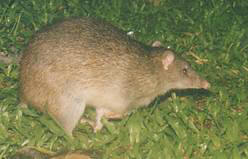Northern Brown Bandicoot 
Photo: Courtesy of Damon Ramsey
BSc.(Zool) Biologist GuideNorthern Brown Bandicoot: Isoodon macrourus - Other common names for this bandicoot include the Bridled Bandicoot, Giant Bridled Bandicoot, Long-tailed Short-nosed Bandicoot, and Large Northern Bandicoot.
- It is a omnivorous marsupial with a reverse pouch, so that will not fill with soil when digging.
- Speckled brown-black coat covers its back, with its underside light in colour.
- Short-sighted.
Habitat and Distribution: - Common in the rainforest
- Found in areas of low ground cover, including tall grass and dense shrubbery. Habitats include grassland, woodland, open forest and occasionally closed forest.
- Days are spent in a well concealed nest which has a heap of ground litter covering a shallow dip, hence providing an underground enclosure with loose regions at each end for entry and exit.
- It often kicks a layer of soil over the top of the nest when its rains for water proofing.
- They also sometimes rest in hollow logs or under tussocks.
- This bandicoot lives in the generally higher rainfall zones from the east coast of Australia north of the Hawkesbury River to the tip of Cape York in Queensland, and across to the Northern Territory and northern Western Australia.
Diet: - The Northern Brown Bandicoot is omnivorous, and as well as eating insects, spiders and earthworms, it enjoys berries, grass seeds and plant fibres such as sugar cane too.
- In search for food it moves over a home range of 1-6 hectares at night.
- It obtains food from the rainforest floor, rotted logs or by digging underground with their forepaws.
- Males are more aggressive and have larger feeding ranges than females.
- Males have bigger home ranges.
- To mark the ground and vegetation during aggressive encounters, a gland behind the ear is used.
- Males and females only come together during the mating season.
Viewing opportunities: - Will often be seen after dark at Chambers Wildlife Rainforest Lodge digging in the rainforest floor.
- Commonly seen on Lake Eacham roadway illuminated by the car headlights.
Breeding: - The males and females only appear to come together for mating.
- Breeding may occur throughout the year in Queensland, but only in the late winter in New South Wales.
- Some females may become pregnant again when the young are about 50 days old.
- A high reproductive rate is possible as females become sexually mature before they are fully grown and can produce several litters in the one breeding season.
Additional Information: Damon Ramsey This animal is the size of a large rabbit, with a pear shape and short ears. It has a long nose and stiff, spiky brown hair. It is the more commonly encountered bandicoot in the rainforest because it occurs on the edge of the forest, along roads, and in more open habitats, than the long-nosed bandicoot.
Script: Courtesy of Damon Ramsey BSc.(Zool) Biologist Guide
Additional Bandicoot Information
Additional Bandicoot Photos
Northern Brown Bandicoots of the Lamington National Park.
|
